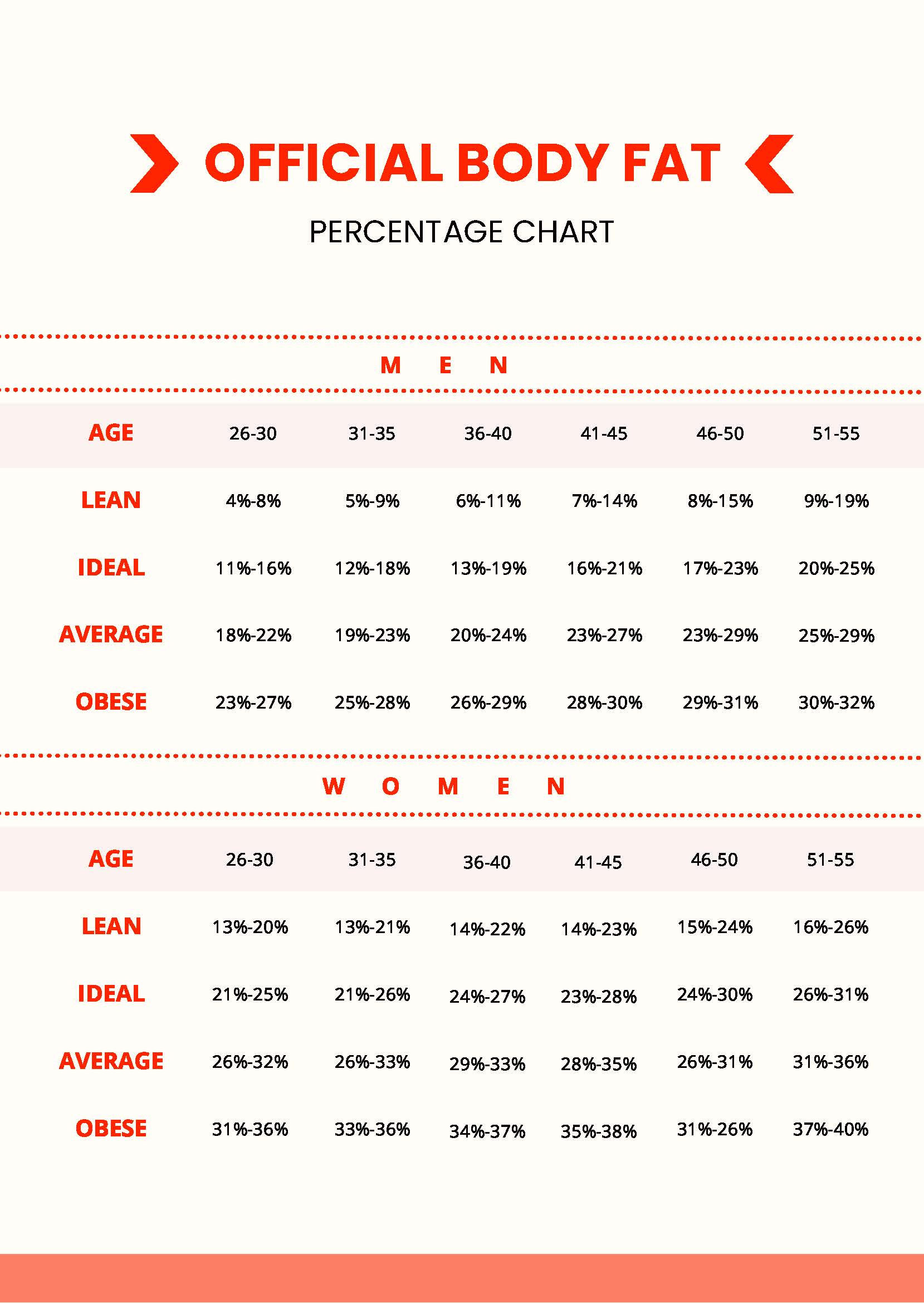درصد چربی بدن (BF) نسبت چربی ( بافت چربی ) نسبت وزن چربی به وزن کل بدن در بدن است. 1 in حال شاخص توده بدنی (BMI) اغلب برای تخمین چربی بدن استفاده میشود، اما همیشه روش دقیقی برای انجام این کار نیست.
برخی پژوهشگران باور دارند که درصد چربی بدن شاخص قابل اعتمادتری برای احتمال مضاعفات سلامتی مرتبط با چاقی مثل بیماری قلبی و دیابت نوع 2
این مقاله به بررسی جداول درصد چربی بدن متوسط در ایالات متحده بر اساس سن و جنسیت، همچنین روش محاسبه آن خواهد پرداخت.

روشهای مختلفی برای اندازهگیری چربی بدن وجود دارد. میتوانید آن را در خانه یا با کمک یک حرفهای، مانند فراهمکننده خدمات بهداشتی، فیزیوتراپیست , یا مربی شخصی اندازهگیری کنید.
روشهایی برای تخمین درصد چربی بدن شامل موارد زیر است: 3
در میانگین، زنان معمولاً درصد چربی بدن بیشتری نسبت به مردان دارند، حتی در BMI یکسان. این احتمالاً به دلیل تفاوتهای در ترکیب بدنی است که بدن زن را برای بارداری پتانسیل آماده میکند.
تغییرات در سطح هورمونها (به خصوص استروژن ) طی دوره زندگی، به ویژه در دوران نوجوانی و پس از پیش از انقطاع ماهیانه , باعث میشود زنان غذای خود را به صورت متفاوت فراهم کنند و چربی را راحتتر ذخیره کنند.
دادههای زیر در مورد درصد چربی بدن میانگین مردان و زنان در ایالات متحده آمریکا از طریق نظرسنجی سلامت و تغذیه ملی جمعآوری شده است و توسط مرکز کنترل و جلوگیری از بیماریها (CDC) توزیع شده است. 5
همانطور که توسط CDC گزارش شده است، میزان درصد چربی بدن میانگین در میان مردان و زنان در ایالات متحده آمریکا به شرح زیر است

میانگین کلی درصد چربی بدن در ایالات متحده آمریکا حدوداً ۳۹٫۹٪ برای زنان و ۲۸٫۱٪ برای مردان است، بنابراین مقدار کمتر از این اعداد فنیاً «زیر میانگین» خوانده میشود. با این حال، بیشتر افراد در ایالات متحده معمولاً درصد BF بالاتری نسبت به پیشنهاد شده دارند. 6
بر اساس شورای آمریکایی برای تمرین (ACE)، محدوده درصد چربی بدن ۲۵٪ تا ۳۱٪ برای زنان یا ۱۸٪ تا ۲۴٪ برای مردان برای متوسط غیرورزشکاران عادی است. درصد BF کمتر از ۱۴٪ برای زنان یا ۶٪ برای مردان ممکن است به عنوان بسیار کم و خطرناک در نظر گرفته شود و میتواند منجر به مخاطرات سلامتی شود. 7
در ایالات متحده، چربی بدن بالای میانگین حدوداً ۴۰٪ یا بیشتر برای زنان و ۲۸٪ برای مردان است. 6با این حال، تحقیقات نشان میدهد که مردانی که چربی بدن آنها ۲۵٪ یا بیشتر و زنانی که چربی بدن آنها ۳۵٪ یا بیشتر است، ممکن است خطر قابل توجهی از مشکلات سلامتی مرتبط، مانند بیماری قلبی عروقی (CHD) داشته باشند. تحقیقات دیگر حد بالای بهینه برای زنان را ۳۲٪ در نظر گرفتهاند.
بر اساس CDC، این میزان درصد چربی بدن تخمینی میانگین در میان گروههای مختلف سنی است:

هیچ درصد چربی بدن بهینه واحدی وجود ندارد. به جای آن، مقدار مناسب چربی بدن برای شما به عادتهای غذایی خاص شما، نیازهای تغذیهای، شرایط سلامتی پنهان و اهداف خاص شما بستگی دارد.
برای مثال، ورزشکار حرفهای معمولاً درصد چربی بدن ایدهآل بسیار پایینتری نسبت به فردی با سطح فعالیت فیزیکی معمولی دارد.
مجلس آمریکایی برای تمرینات با موفقیت دامنههای درصد چربی بدن (BF) پتانسیل برای مردان در سطوح مختلف برازندگی فیزیکی به دست آورده است: 7
محدوده درصد چربی بدن زنان در سطوح مختلف برازندگی به شرح زیر است:
اگر میخواهید درصد چربی بدن خود را کاهش دهید یا افزایش دهید، با فرد مراقب سلامت همکاری کنید تا طرح غذایی و تمرینی که برای شما مناسب است را تنظیم کنید. 7
وجود چربی بیش از حد در ناحیه شکمی با خطر بیشتری از عوارض سلامتی مختلف، از جمله بیماری قلبی، دیابت و سکته مغزی مرتبط است. تحقیقات نشان میدهد که انجام تمرین هوشیارانه با شدت متوسط تا بالا حداقل برای ۱۵۰ دقیقه در هفته میتواند به طور معناداری محیط کمربند شما را کاهش دهد و خطر مشکلات سلامتی مزمن را کاهش دهد. 9

بسیاری از محققان باور دارند که درصد چربی بدن ۲۵٪ یا بیشتر برای مردان و ۳۲٪ تا ۳۵٪ یا بیشتر برای زنان ممکن است به شدت بالا باشد. با این حال، شما باید با فرد مراقبتکننده سلامت صحبت کنید تا اهداف مناسبی برای بدن خود تنظیم کنید، بر اساس رژیم غذایی و سطح فعالیت فیزیکی خود.
 اخبار داغ
اخبار داغ 2024-12-16
2024-11-21
2024-10-17
2024-09-06
2024-01-24
2024-01-10